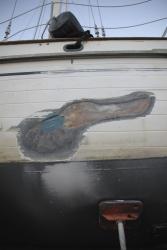 A year ago, we brought our boat to Deltaville,Virginia for a few "quick repairs". During a previous stay in Baltimore, junk floating in the harbor exposed some poor repairs in the hull above the waterline that had been made sometime in the nebulous past before we owned the boat. We also asked the yard to look into a leak letting water into our v-berth when sailing into the wind, which ultimately led to us getting a brand new bowsprit, custom built and replacing the old which was discovered to be rotten.
A year ago, we brought our boat to Deltaville,Virginia for a few "quick repairs". During a previous stay in Baltimore, junk floating in the harbor exposed some poor repairs in the hull above the waterline that had been made sometime in the nebulous past before we owned the boat. We also asked the yard to look into a leak letting water into our v-berth when sailing into the wind, which ultimately led to us getting a brand new bowsprit, custom built and replacing the old which was discovered to be rotten.
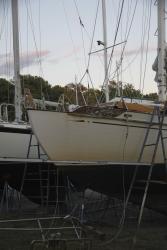 Midway through these repairs, a surprise two-week work-trip to London evolved into four grueling months abroad. After London, I followed Jamie to Washington DC, and then to Oregon for her work, and before we knew it a year had passed off of the boat. During it all, the good and the bad, we consistently missed being aboard and dreamed of returning to the cruising life. Having previously explored the Eastern Seaboard for a couple of years, we concluded it's time to head into the Caribbean and step up the boating lifestyle a notch.
Midway through these repairs, a surprise two-week work-trip to London evolved into four grueling months abroad. After London, I followed Jamie to Washington DC, and then to Oregon for her work, and before we knew it a year had passed off of the boat. During it all, the good and the bad, we consistently missed being aboard and dreamed of returning to the cruising life. Having previously explored the Eastern Seaboard for a couple of years, we concluded it's time to head into the Caribbean and step up the boating lifestyle a notch.
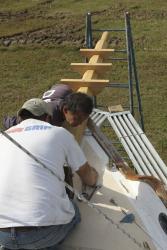 A great time to head south into the Caribbean is immediately after hurricane season, before winter has fully set in. It's a 1,300 mile passage from the mouth of the Chesapeake to the Virgin Islands, across open ocean -- you can head toward Bermuda first, but that adds about 200 miles to the trip. At 5 knots, that's 10 and a half days at sea, a long time away from land!
A great time to head south into the Caribbean is immediately after hurricane season, before winter has fully set in. It's a 1,300 mile passage from the mouth of the Chesapeake to the Virgin Islands, across open ocean -- you can head toward Bermuda first, but that adds about 200 miles to the trip. At 5 knots, that's 10 and a half days at sea, a long time away from land!
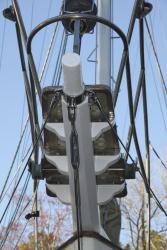 As this will be our longest open-ocean crossing, we decided to participate in the Caribbean 1500. This is a unique opportunity to make the crossing together with a number of other like-minded individuals, and requires us to properly outfit the boat for safety.
As this will be our longest open-ocean crossing, we decided to participate in the Caribbean 1500. This is a unique opportunity to make the crossing together with a number of other like-minded individuals, and requires us to properly outfit the boat for safety.
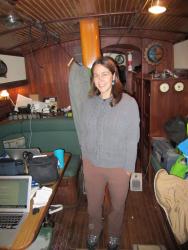 Before leaving Deltaville, we dipped into our house savings and made a huge number of important improvements to the boat. Above decks, we added a storm track allowing us to easily drop the mainsail and fly a storm trysail if a storm blows up; we repaired a number of leaks to the cabin top over the galley and quarterberth; we rigged up a second anchoring system; we repaired our jib furling system; we replaced our Walker Bay dinghy with a roll up inflatable with an Aluminum deck can be stored on deck during long crossings, also downsizing our 4 horsepower Mercury outboard to a significantly lighter 2.3 horsepower Honda that Jamie can manhandle by herself; and insulated our backstay and added a Dynaplate ground below the waterline together providing a proper SSB antenna.
Before leaving Deltaville, we dipped into our house savings and made a huge number of important improvements to the boat. Above decks, we added a storm track allowing us to easily drop the mainsail and fly a storm trysail if a storm blows up; we repaired a number of leaks to the cabin top over the galley and quarterberth; we rigged up a second anchoring system; we repaired our jib furling system; we replaced our Walker Bay dinghy with a roll up inflatable with an Aluminum deck can be stored on deck during long crossings, also downsizing our 4 horsepower Mercury outboard to a significantly lighter 2.3 horsepower Honda that Jamie can manhandle by herself; and insulated our backstay and added a Dynaplate ground below the waterline together providing a proper SSB antenna.
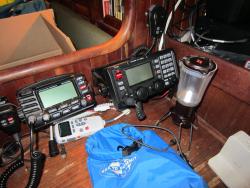 Below decks, we discovered our newish AGM battery bank had overheated and several had burst, no longer holding a charge, so all were replaced; the low-end battery charger was upgraded to a fancy (expensive) new charger with temperature sensors and fans to avoid burning up the batteries again; our original 1977 electricity panel (complete with constant shorts and odd quirks) was replaced with a fancy new panel; an autopilot was connected to the windvane allowing automatic steering now under wind or under engine power; custom shelves were built behind the settee cushions allowing proper stowage of food in a manner allowing us to find things again; custom lee cloths were sewed and installed for comfort and safety in rough seas and under heel; porthole gaskets were replaced attempting to fix various leaks; a new "ditch bag" was outfitted with safety gear including flares and an EPIRB; the VHF was upgraded to a newer model with DSC (think "telephone number on the ocean", and a unique ID during an emergency situation); an AIS transceiver was added to report location, heading and speed to similarly rigged nearby boats; and an SSB was installed for both voice and limited text email and weather transmissions.
Below decks, we discovered our newish AGM battery bank had overheated and several had burst, no longer holding a charge, so all were replaced; the low-end battery charger was upgraded to a fancy (expensive) new charger with temperature sensors and fans to avoid burning up the batteries again; our original 1977 electricity panel (complete with constant shorts and odd quirks) was replaced with a fancy new panel; an autopilot was connected to the windvane allowing automatic steering now under wind or under engine power; custom shelves were built behind the settee cushions allowing proper stowage of food in a manner allowing us to find things again; custom lee cloths were sewed and installed for comfort and safety in rough seas and under heel; porthole gaskets were replaced attempting to fix various leaks; a new "ditch bag" was outfitted with safety gear including flares and an EPIRB; the VHF was upgraded to a newer model with DSC (think "telephone number on the ocean", and a unique ID during an emergency situation); an AIS transceiver was added to report location, heading and speed to similarly rigged nearby boats; and an SSB was installed for both voice and limited text email and weather transmissions.
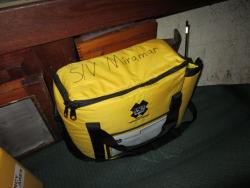 Hurricane Sandy helped motivate us to accelerate getting the boat back into the water and headed south to Hampton where the race starts. After one full year of sitting "on the hard", I was extremely pleased that our engine started easily and ran smoothly, allowing us to aggressively motor-sail an entire day, comfortably racing south ahead of the storm. We confirmed that the jib furling repair worked well, flying a portion of our genoa the whole way allowing us to cruise downwind at an impressive 7.5 knots -- the newly painted and perfectly clean bottom certainly helping.
Hurricane Sandy helped motivate us to accelerate getting the boat back into the water and headed south to Hampton where the race starts. After one full year of sitting "on the hard", I was extremely pleased that our engine started easily and ran smoothly, allowing us to aggressively motor-sail an entire day, comfortably racing south ahead of the storm. We confirmed that the jib furling repair worked well, flying a portion of our genoa the whole way allowing us to cruise downwind at an impressive 7.5 knots -- the newly painted and perfectly clean bottom certainly helping.
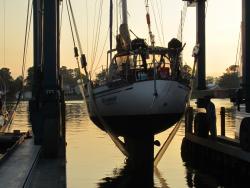 Leaving Deltaville was a strange experience -- with a multi-day line of boats waiting to get safely hauled out onto dry land to wait out the storm, we had our boat lowered back into the water. The media was in a frenzy over the large and growing storm heading up from the south, which we were preparing to sail right toward. The morning arrived, and before we knew it we were underway -- it proved to be a good choice, we enjoyed 10-15 knots of wind on our stern and 2-3 foot following seas the entire way. I felt a little queasy in the beginning after our year as land lubbers, but looked nothing as sickly as our boat cat, Quixote, who had clearly lost his sea legs.
Leaving Deltaville was a strange experience -- with a multi-day line of boats waiting to get safely hauled out onto dry land to wait out the storm, we had our boat lowered back into the water. The media was in a frenzy over the large and growing storm heading up from the south, which we were preparing to sail right toward. The morning arrived, and before we knew it we were underway -- it proved to be a good choice, we enjoyed 10-15 knots of wind on our stern and 2-3 foot following seas the entire way. I felt a little queasy in the beginning after our year as land lubbers, but looked nothing as sickly as our boat cat, Quixote, who had clearly lost his sea legs.
 Arriving in Hampton, we immediately set to work preparing the boat for hurricane winds -- we secured ourself with countless lines, tying backups to backups, and removed everything we could from the decks to minimize windage. Fortunately, as I write this the last of the gusts from Hurricane Sandy are winding down, never getting above 30 knots -- it proved to be a very mild storm for us. Hopefully those north of us where the storm is currently headed inland will fare as well. The worst we saw was a little flooding, but not enough to even cause us to lose power.
Arriving in Hampton, we immediately set to work preparing the boat for hurricane winds -- we secured ourself with countless lines, tying backups to backups, and removed everything we could from the decks to minimize windage. Fortunately, as I write this the last of the gusts from Hurricane Sandy are winding down, never getting above 30 knots -- it proved to be a very mild storm for us. Hopefully those north of us where the storm is currently headed inland will fare as well. The worst we saw was a little flooding, but not enough to even cause us to lose power.
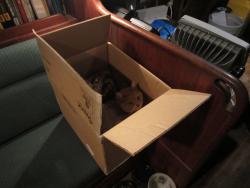 This week we're finalizing preparations for the race. We're attending seminars from people that have made this trip many times before, and we're stowing provisions and gear in preparations for two more crew members -- Bill Spivey (aka Captain Ron, our long time sailing mentor), and Bill Read whom we met through the race and has made the trip twice before. Four people onboard will allow for three hours on and nine hours off, ideally allowing us to get sufficient rest during the trip. Next week this time we'll be four people on a 37 foot boat crossing the open ocean. And in a couple short weeks, we'll be starting a new life in the Caribbean!
This week we're finalizing preparations for the race. We're attending seminars from people that have made this trip many times before, and we're stowing provisions and gear in preparations for two more crew members -- Bill Spivey (aka Captain Ron, our long time sailing mentor), and Bill Read whom we met through the race and has made the trip twice before. Four people onboard will allow for three hours on and nine hours off, ideally allowing us to get sufficient rest during the trip. Next week this time we'll be four people on a 37 foot boat crossing the open ocean. And in a couple short weeks, we'll be starting a new life in the Caribbean!